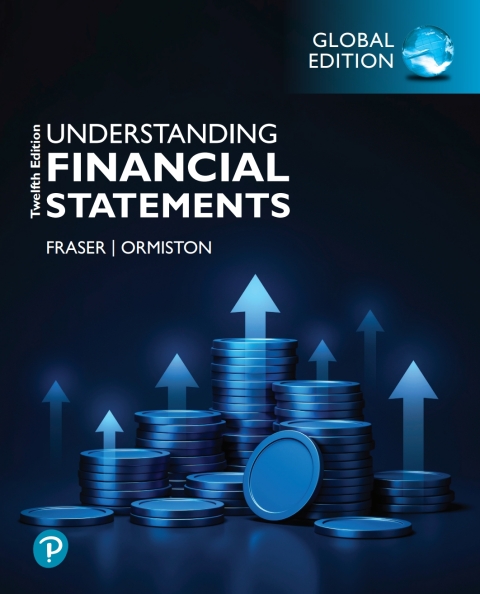Description
Efnisyfirlit
- Title Page
- Copyright Page
- Dedication
- Pearson’s Commitment to Diversity, Equity, and Inclusion
- Contents
- Preface to the Twelfth Edition
- Organization of the Twelfth Edition
- Uses for the Twelfth Edition
- Features of the Twelfth Edition
- Acknowledgments
- Author Bio
- Chapter 1. Financial Statements: An Overview
- Map or Maze
- Usefulness
- Volume of Information
- Global Economy
- Where to Find a Company’s Financial Statements
- The Financial Statements
- Notes to the Financial Statements
- Auditor’s Report
- Financial Reporting Reforms
- Management Discussion and Analysis
- Pandora (a.k.a. “PR Fluff”)
- Proxy Statement
- Missing and Hard-to-Find Information
- Characteristics, Assumptions, Principles, and Basis of Accounting
- Complexities and the Quality of Financial Reporting
- Accounting Choices
- Timing of Revenue and Expense Recognition
- Discretionary Items
- The Journey Through the Maze Continues
- Appendix 1A. Sage Inc. 2024 Annual Report
- Self-Test
- Study Questions and Problems
- Case 1.1 Analysis Case
- Case 1.2 Comprehensive Team Analysis Case
- Case 1.3 Locating Information in a Form 10-K
- Case 1.4 CPA Evolution Model Curriculum Case
- Chapter 2. The Balance Sheet
- Financial Condition
- Consolidation
- Balance Sheet Date
- Comparative Data
- Balance Sheet Format
- Common-Size Balance Sheet
- Assets
- Current Assets
- Cash and Cash Equivalents
- Marketable Securities
- Accounts Receivable
- Inventories
- Inventory Accounting Methods
- Prepaid Expenses
- Property, Plant, and Equipment
- Straight Line
- Accelerated
- Cryptocurrency
- Goodwill
- Other Assets
- Liabilities
- Current Liabilities
- Accounts Payable
- Short-Term Debt
- Current Maturities of Long-Term Debt
- Accrued Liabilities
- Unearned Revenue or Deferred Credits
- Deferred Federal Income Taxes
- Long-Term Debt
- Leases
- Pensions and Postretirement Benefits
- Commitments and Contingencies
- Stockholders’ Equity
- Common Stock
- Additional Paid-In Capital
- Retained Earnings
- Other Equity Accounts
- Quality of Financial Reporting—The Balance Sheet
- Other Balance Sheet Items
- Self-Test
- Study Questions and Problems
- Case 2.1 Analysis Case
- Case 2.2 Comprehensive Team Analysis Case
- Case 2.3 CPA Evolution Model Curriculum Case
- Chapter 3. Income Statement, Comprehensive Income, and Statement of Stockholders’ Equity
- The Income Statement and Comprehensive Income
- Common-Size Income Statement
- Net Sales
- Cost of Goods Sold
- Gross Profit
- Operating Expense
- Operating Profit
- Other Income (Expense)
- Equity Earnings
- Unusual and Infrequent Items
- Earnings before Income Taxes/Effective Tax Rate
- Discontinued Operations
- Net Earnings
- Earnings per Common Share
- Statement of Comprehensive Income
- The Statement of Stockholders’ Equity
- Earnings Quality, Cash Flow, and Segmental Accounting
- Appendix 3A. A Guide to Earnings Quality
- Self-Test
- Study Questions and Problems
- Case 3.1 Analysis Case
- Case 3.2 Comprehensive Team Analysis Case
- Case 3.3 CPA Evolution Model Curriculum Case
- Chapter 4. Statement of Cash Flows
- Why Cash Flow Is Important: An Example
- Statement of Cash Flows: Basic Principle
- Preparing a Statement of Cash Flows
- Calculating Cash Flow from Operating Activities
- Indirect Method
- Cash Flow from Investing Activities
- Cash Flow from Financing Activities
- Change in Cash
- Analyzing the Statement of Cash Flows
- Cash Flow from Operations
- Nocash Corporation
- Sage Inc.: Analysis of the Statement of Cash Flows
- Sage Inc. Analysis: Cash Flow from Operating Activities
- Summary Analysis of the Statement of Cash Flows
- Analysis of Cash Inflows
- Analysis of Cash Outflows
- Qualitative Issues Relating to the Statement of Cash Flows
- Are We There Yet?
- Appendix 4A. Statement of Cash Flows—Direct Method
- Self-Test
- Study Questions and Problems
- Case 4.1 Analysis Case
- Case 4.2 Comprehensive Team Analysis Case
- Case 4.3 CPA Evolution Model Curriculum Case
- Chapter 5. The Analysis of Financial Statements
- Objectives of Analysis
- Sources of Information
- Proxy Statement
- Auditor’s Report
- Management Discussion and Analysis
- Supplementary Schedules
- Form 10-K and Form 10-Q
- Other Sources
- Tools and Techniques
- Common-Size Financial Statements
- Key Financial Ratios
- Liquidity Ratios: Short-Term Solvency
- Cash Conversion Cycle or Net Trade Cycle
- Activity Ratios: Asset Liquidity, Asset Management Efficiency
- Leverage Ratios: Debt Financing and Coverage
- Profitability Ratios: Overall Efficiency and Performance
- Market Ratios
- Analyzing the Data
- Background: Economy, Industry, and Firm
- Short-Term Liquidity
- Operating Efficiency
- Capital Structure and Long-Term Solvency
- Profitability
- Relating the Ratios—The Du Pont System
- Projections and Pro Forma Statements
- Summary of Analysis
- Financial Statements: A Map
- Appendix 5A. The Analysis of Segmental Data
- Self-Test
- Study Questions and Problems
- Case 5.1 Analysis Case
- Case 5.2 Comprehensive Team Analysis Case
- Case 5.3 CPA Evolution Model Curriculum Case
- Appendixes
- Appendix A. Summary of Financial Ratios
- Appendix B. Solutions to Self-Tests
- Appendix C. Glossary
- Index
- A
- B
- C
- D
- E
- F
- G
- H
- I
- J
- K
- L
- M
- N
- O
- P
- Q
- R
- S
- T
- U
- V
- W
- X








Reviews
There are no reviews yet.